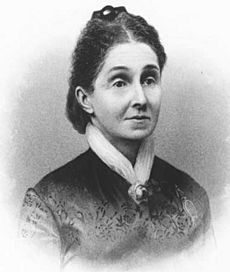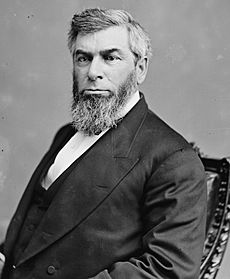Minor v. Happersett facts for kids
Quick facts for kids Minor v. Happersett |
|
|---|---|

|
|
| Argued February 9, 1875 Decided March 29, 1875 |
|
| Full case name | Virginia Minor v. Reese Happersett |
| Citations | 88 U.S. 162 (more)
21 Wall. 162; 22 L. Ed. 627
|
| Prior history | Appeal from the Supreme Court of Missouri; 53 Mo. 58 (1873) |
| Holding | |
| The Fourteenth Amendment does not guarantee women the right to vote. | |
| Court membership | |
| Case opinions | |
| Majority | Waite, joined by unanimous |
| Laws applied | |
| U.S. Const. amend. XIV | |
|
Superseded by
|
|
| U.S. Const. amend. XIX (in part) | |
Minor v. Happersett was an important case decided by the Supreme Court of the United States in 1875. The Court had to decide if women, as citizens, had the right to vote.
The Supreme Court decided that even though women are citizens, the U.S. Constitution did not automatically give them the right to vote. This meant that states could make their own laws about who could vote. At the time, many states only allowed men to vote. This ruling was later changed by the Nineteenth Amendment in 1920.
Contents
Why Was This Case Important?
This case was about whether the Fourteenth Amendment gave women the right to vote. This amendment says that all people born or naturalized in the U.S. are citizens. It also says that states cannot take away the "privileges or immunities" of citizens.
Virginia Minor and her husband argued that voting was one of these "privileges" of citizenship. However, the Supreme Court disagreed. They said that being a citizen did not automatically mean you had the right to vote.
What Happened in the Case?
Virginia Minor was a leader in the women's suffrage movement in Missouri. Suffrage means the right to vote. On October 15, 1872, she tried to register to vote in St. Louis County, Missouri.
However, the registrar, Reese Happersett, refused her application. He said she could not vote because she was a woman. At that time, Missouri law only allowed men to vote.
Virginia Minor, with help from her husband, Francis Minor, sued Reese Happersett. They argued that Missouri's law went against the U.S. Constitution, especially the Fourteenth Amendment. They believed that if you were a citizen, you should have the right to vote.
The case first went to the Missouri Supreme Court. This court decided against Virginia Minor. They pointed out that most states had always only allowed men to vote. They also said the Fourteenth Amendment was mainly meant to give rights to former slaves, not to change voting rules for everyone else.
The Missouri court also noted that the Fourteenth Amendment mentioned "male citizens" when talking about voting rights. This seemed to suggest that states could limit voting to men.
Virginia Minor then appealed her case to the Supreme Court of the United States. She made the same arguments there. She also suggested that allowing women to vote would fit with what the people who wrote the Constitution originally intended.
Missouri did not send a lawyer to defend its decision. Instead, they sent a short statement explaining why they thought their law was correct. The Supreme Court heard the arguments on February 9, 1875, and made its decision on March 29, 1875.
The Court's Decision
The Supreme Court's decision was unanimous, meaning all the judges agreed. They upheld Missouri's law. They said that voting was not a basic right of being a citizen. They also said the Constitution did not give or take away voting rights for women. Therefore, allowing only men to vote did not violate Virginia Minor's rights under the Fourteenth Amendment.
Chief Justice Morrison Waite wrote the opinion for the Court. He first confirmed that Virginia Minor was indeed a U.S. citizen. He explained that people born in the U.S. to U.S. citizen parents are citizens.
Then, the Court looked at whether the right to vote was one of the "privileges or immunities" of citizens when the Fourteenth Amendment was adopted in 1868. They looked at historical records and found that it was not.
The Court explained that the U.S. Constitution did not clearly state that citizens had a right to vote. They noted that throughout U.S. history, many citizens, including women, were not allowed to vote. For example, when the Constitution was first written, none of the original Thirteen Colonies allowed all citizens to vote. They had rules based on things like gender, race, age, or owning land.
The Court concluded that if the Constitution's writers had wanted all citizens to be able to vote, they would have said so clearly. Such a big change would not have been left unsaid.
How the Case Changed History
The decision in Minor v. Happersett meant that women still could not vote based on their citizenship. However, this changed in 1920. The Nineteenth Amendment was added to the Constitution. This amendment made it illegal to deny any U.S. citizen the right to vote based on their sex. This effectively overturned the main ruling of Minor v. Happersett.
Even after 1920, the Minor case was sometimes used to support other laws that made it harder to vote. These included laws about poll taxes (fees to vote) and literacy tests (tests to prove you could read and write).
However, in the 1960s, the Supreme Court started to see voting as a very important right. They began to use the Equal Protection Clause of the Fourteenth Amendment to protect voting rights for all citizens. This meant that laws that discriminated against certain groups in voting were no longer allowed.



